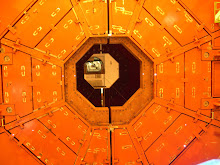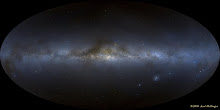 The Mayan influence on the floor of the CERN Visitor Center, artist Serge Moro. A friend ribbed me about the previous post on Nostradamus And The LHC, you can read anything you want into those quatrains. It's Art, I should have said, that's what Art does. There are over 10,000 dissertations on Hamlet alone, and more than a 100,000 published articles. You should throw in the Mayans too while you're at it, he went on. The famous Mayan Calendar, the long count, that expires or starts over in 2012, some taking that as the end of the world. See if you can tie that in with CERN! As you can see, CERN did it themselves, unconsciously or consciously, doesn't matter which. Both are equally valid motions, conjuring up some tie with the past and the future or building on the past or stealing some glory, like the Roman Capital in Washington, DC or Fermilab's Stonehenge Computer Center in my earlier post 'The Tevatron Connection' of April 2008.
The Mayan influence on the floor of the CERN Visitor Center, artist Serge Moro. A friend ribbed me about the previous post on Nostradamus And The LHC, you can read anything you want into those quatrains. It's Art, I should have said, that's what Art does. There are over 10,000 dissertations on Hamlet alone, and more than a 100,000 published articles. You should throw in the Mayans too while you're at it, he went on. The famous Mayan Calendar, the long count, that expires or starts over in 2012, some taking that as the end of the world. See if you can tie that in with CERN! As you can see, CERN did it themselves, unconsciously or consciously, doesn't matter which. Both are equally valid motions, conjuring up some tie with the past and the future or building on the past or stealing some glory, like the Roman Capital in Washington, DC or Fermilab's Stonehenge Computer Center in my earlier post 'The Tevatron Connection' of April 2008.Human experience is broad and varied. Looking at the big picture has made for great civilizations. Today's narrow focus into specialities has isolated many of our most able and brilliant people into pigeon holes. Other pigeons might communicate with them, but we don't and they don't bother. So we drift into a future nobody particularly cares for.
I'd remind scientists that before modern science there was science fiction, that gave science a tremendous push, starting say with the Victorians like HG Wells and Jules Verne. In 1895 Wells wrote in 'The Time Machine', "There is no difference between Time and any of the three dimensions of Space except that our consciousness moves along it." He added, "Scientific people . . . know very well that Time is only a kind of Space." An impressive insight coming well before Einstein's Spacetime.
If societies took Art as seriously as Science we could avoid some trouble brewing in science, the other aspect of sci-fi. These visionary works should caution us as well as inspire, like those of Jules Verne. Besides his scientific adventures and futuristic novels, he wrote one bleak and realistic novel approximating our own time. His publisher discouraged him, saying it would damage his reputation and disappoint his public. 'Paris in the 20th Century' was forgotten, only to resurface in 1994. Written with a uncanny prophetic power in 1863, it characterizes not only a technologically modern Paris of today with glass skyscrapers and cars, worldwide communications and even a geometric centerpiece at the Louvre, the IM Pei pyramid, it reflects the modern state of big business and science as the only virtues, even the women emancipated into the workforce and necessarily masculinized. Look on the right, this odyssey might not last.
So before some physicists laugh at CERN, Nostradamus, les Maya et quoi encore? The big picture of the big collider sleeping underground could just wake up like the proverbial fire-breathing dragon.
 Cointrin
Cointrin

























No comments:
Post a Comment